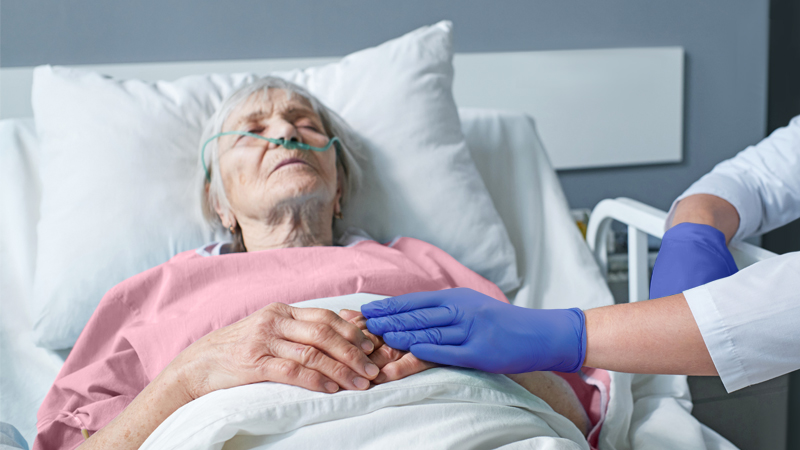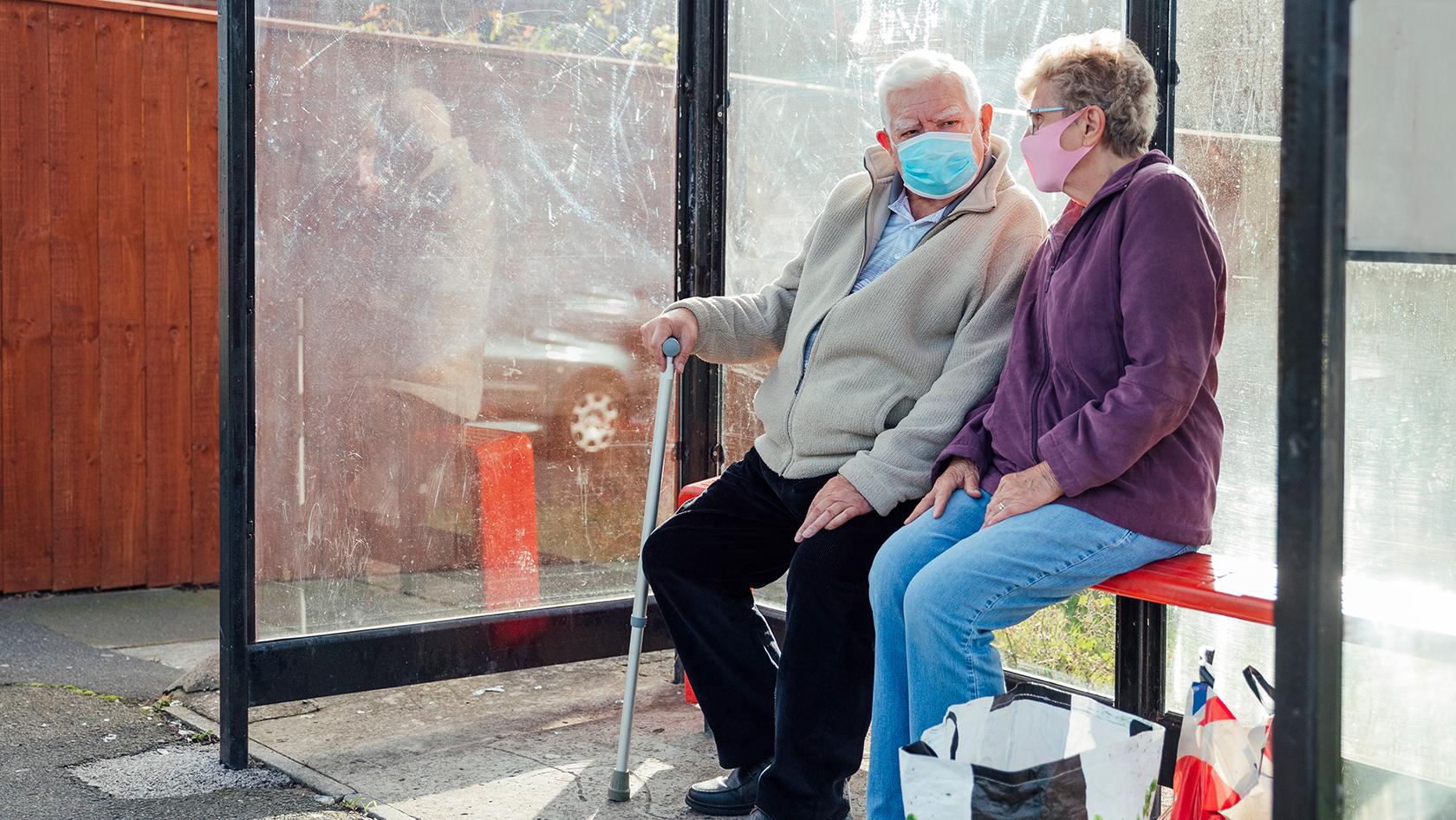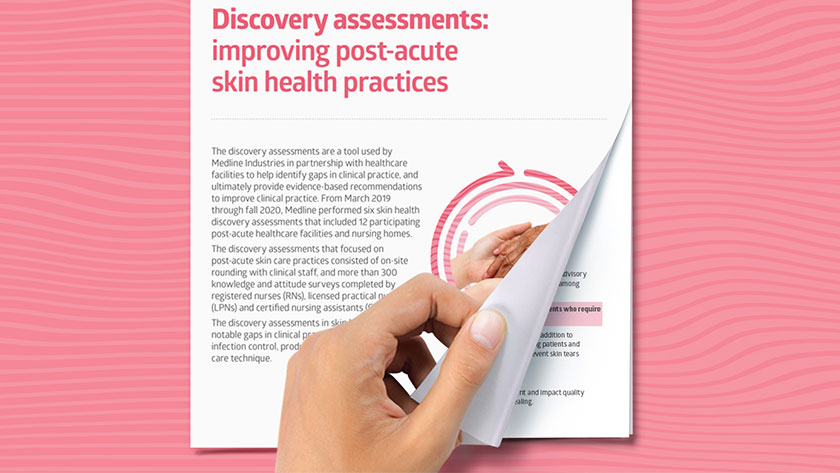Skin failure at life’s end or pressure injury: What you need to know
Labels and their limitations for unusual skin changes at the end of life.

You work hard to prevent skin breakdown and, with an aging population, it’s a constant concern. But what about for individuals who are dying?
Skin changes at life’s end—sometimes referred to as SCALE—can be challenging to manage and sometimes confusing to understand. It’s important to consider the complex issues, how these skin changes may differ from typical pressure injuries and what you can do to continue to care for fragile skin, even during the last days or weeks of life.
Read on to review the various terms used to describe these skin changes, some of the conflicting priorities for terminally ill patients, and best practices for caring for their skin.
Skin changes as part of the dying process
Whether in a hospital, hospice care or other care setting, caregivers often see alterations in skin color at the sacrum of people who are dying. The color is usually purple or maroon and appears within days before they die.
“There is a phenomenon of skin breakdown that is unavoidable at the end of life.”

Joyce Black
PhD, RN, FAAN, NPIAP Board Executive Committee Member and Medline consultant
At first, the skin condition might appear to be a pressure injury. But upon closer inspection or even post-mortem, it becomes clear that the characteristics don’t match the textbook pressure injury.
“There is a phenomenon of skin breakdown that is unavoidable at the end of life,” notes Joyce Black, PhD, RN, FAAN, NPIAP Board Executive Committee Member and Medline consultant.
In November 2021, the National Pressure Injury Advisory Panel hosted “Unavoidable Skin Changes at the End of Life,” a special event meant to bring attention to these anomalies and the scarcity of science associated with them. Dr. Black was a co-host with NPIAP President, Bill Padula, PhD, MS, MSc.
During the program, Dr. Black presented several examples of purple discoloration at the sacrum in patients who died several days after the skin change was reported. The data included thermographic images to measure the blood flow to the areas, as well as biopsies.
Using solely the visual cues, many wound care experts would have assessed the skin in the photos as having a suspected deep tissue pressure injury.
Using solely the visual cues, many wound care experts would have assessed the skin in the photos as having a suspected deep tissue pressure injury. But here’s the mystery, says Dr. Black: “It didn’t show anything histologically of a pressure injury at all. It didn’t show perfusion anomalies or hyperinflammatory changes, both of which would show up if it were a pressure injury.”
“I don’t think we see it on every dying patient, but when we see it, because it presents as a purple or maroon area, it tends to get classified as a DTI,” Dr. Black says. “I think we should stop calling it a pressure injury.”
But if it’s not a pressure injury, then what is it?
Kennedy terminal ulcer and other labels
Over the past several decades, these skin color alterations and other pressure injury-type skin changes have been given various names and slightly different descriptions. Here are a few:
- Kennedy terminal ulcer. This is the most popular label, and one that has stuck since Karen Lou Kennedy-Evans introduced it at the first National Pressure Injury Advisory Panel in Washington, DC, in 1989. Kennedy-Evans presented photos of butterfly- and pear-shaped discoloration on the sacrum that started suddenly and progressed quickly. For better or for worse, the “ulcer” part of the name lumped it squarely in with pressure injuries. In a recent survey, “more than 90% of the respondents agreed that KTUs are prognostic of impending death.” However, despite this general consensus, there’s very little evidence. In fact, Kennedy’s own research reveals that only about 55% of patients actually died within a 6-week period following the designation of the KTU.1
- 3:30 syndrome. An offshoot of the KTU, this name comes from the literal hour of the day that the skin changes seem to take place. Essentially, some studies show intact skin in the morning and, by the afternoon, what looks like a large wound has developed.
- Trombley-Brennan terminal tissue injury. These particular skin changes were studied by palliative care nurses Kathy Trombley and Mary Brennan in end-of-life patients. Contrasting with the KTU and 3:30 syndrome, Trombley and Brennan found that the discoloration of the tissue was in locations other than the sacrum and, while they could get larger, the skin remained intact. “The interval between the occurrence of the wounds and time of death ranged from 20 minutes to several days.”2
- Skin failure. While it seems this could be a generic umbrella term for all the changes discussed, Dr. Black argues that this implies something that’s misleading: “It means you’ve lost so much skin, you’re going to die.” Skin is the body’s largest organ, so there are cases, such as with burn victims, that skin failure may take a life. But the discoloration observed is on such a small percentage of the body that it doesn’t add up.
At the NPIAP’s special event in 2021, attendees began by creating a “word salad” to reveal how they referred to these non-pressure injury conditions. The most common terminology that came up was “skin failure.” But after research was presented, Dr. Black says that participants’ evaluation had shifted. They determined the best description was instead “skin change associated with dying.”
Conflicting priorities that make end-of-life care difficult
Although you implement all your best practices to care for skin of older patients or residents, when it comes to the last days of life, one of the challenges is that priorities may conflict.
“Even though we’d like to keep patient skin intact, the patient’s goal is hopefully to talk to their family about what they still need to say. ‘I love you,’ ‘Forgive me,’ ‘I forgive you,’ all those things,” says Dr. Black. “When we go into rooms and focus instead on ‘Let’s get you turned,’ it takes away from the time people have to do that.”
These patients also typically aren’t eating or drinking enough to maintain nutrients for healthy skin, and they may find it difficult or painful to move or be moved. The malnutrition and lack of mobility both raise the risk of pressure injuries.
“The patient’s goal is hopefully to talk to their family about what they still need to say.”

Joyce Black
PhD, RN, FAAN, NPIAP Board Executive Committee Member and Medline consultant
While hospice and palliative care settings don’t need to report pressure injuries, hospitals are required to do so as part of Centers for Medicare & Medicaid Services (CMS) “never events.” Even if the patient is dying. This presents some dilemmas for regulators, Dr. Black points out.
“Once you open that door and say, ‘If this patient is dying, then the pressure injury development is unavoidable,’ and then the patient lives, then we get a ‘pass’ on the pressure injury,” she explains. “It becomes a loophole in reporting.” The fear is that hospitals could use this to skew their PI reporting.
Hospitals are left with this conundrum of, what about the ones we couldn’t prevent?
“CMS actually acknowledged many, many years ago that yes, there were going to be unavoidable pressure injuries,” Dr. Black explains. Discussions at the NPIAP special event included establishing a new diagnosis code using the term “unavoidable.” But Dr. Black says that’s not going to happen any time soon.
3 things you can do for patients who are dying
There’s growing scientific research that shows that some skin changes at the end of life, no matter what you call them, may be unavoidable. Until codes catch up, there are still steps you can take to help care for patients and residents who are dying.
- Maintain preventive practices. Just as you would with anyone at risk for pressure injuries, follow NPIAP guidelines and best practices to nourish at-risk skin with gentle cleansers and moisturizers, select appropriate support surfaces, turn and reposition based on risk, mobility level and patient comfort, and apply prophylactic dressings where appropriate, and other preventive practices.
- Assess and document. It’s important to continue to assess skin and document what you see with descriptions and timing. In addition to aiding the continuum of care, there’s a legal purpose to this, as well as a scientific benefit, helping describe physiological skin changes associated with dying.
- Comfort family. Perhaps the most meaningful job at hand is helping the family through a difficult time. “Help the family have the best possible memories,” Dr. Black advises. Let the person at the end of life do what Dr. Black calls “the work of dying, to leave Earth without a lot of baggage for the people left behind.” She also encourages caregivers to talk with the family members. Sometimes family members request caregivers not turn their loved one because it may be more painful for them. They’d rather their loved one remain comfortable and peaceful. Then be sure to explain what you’ll be doing, and what you won’t be doing.
Key takeaway
Although caregivers like you focus on preventing pressure injuries, some skin changes at the end of life look like pressure injuries, but seem to have different characteristics. Through decades of research and observation, these skin anomalies have been given a variety of labels, and more research is needed to fully understand them. While scientific research grows, it’s important for caregivers to continue to provide best practice care and comfort measures for dying patients and their families.
References:
- Sibbald, R. G., & Ayello, E. A. (2020). Terminal Ulcers, SCALE, Skin Failure, and Unavoidable Pressure Injuries: Results of the 2019 Terminology Survey. Advances in Skin &Amp; Wound Care, 33(3), 137–145. https://doi.org/10.1097/01.asw.0000653148.28858.50.
- Brennan, M. R., Thomas, L., & Kline, M. (2019). Prelude to Death or Practice Failure? Trombley-Brennan Terminal Tissue Injury Update. American Journal of Hospice and Palliative Medicine®, 36(11), 1016–1019. https://doi.org/10.1177/1049909119838969
.




